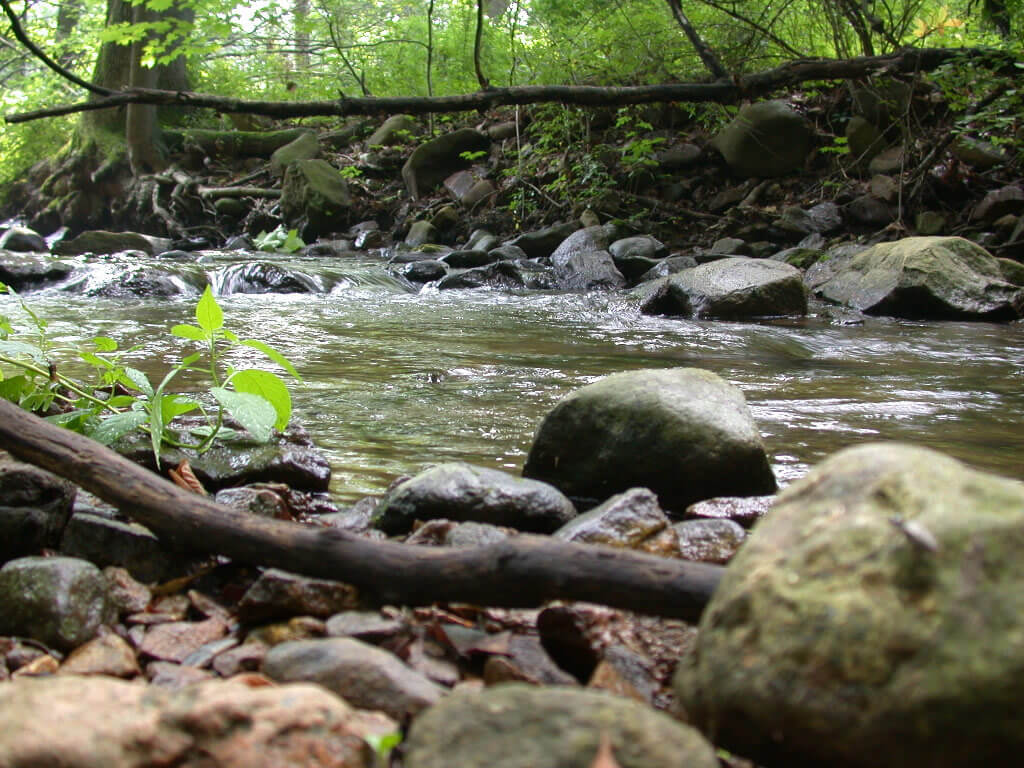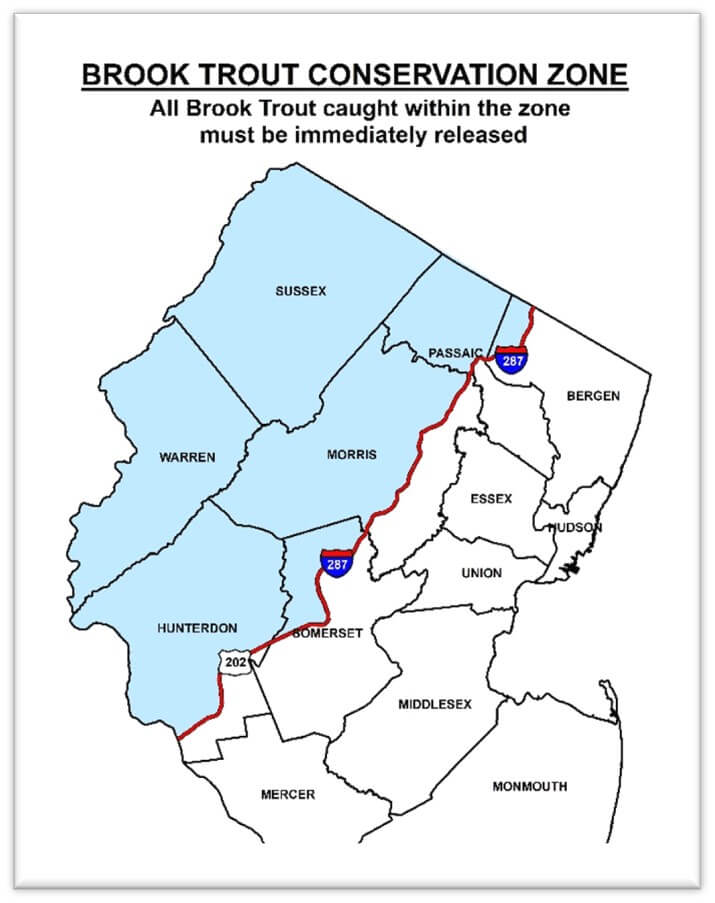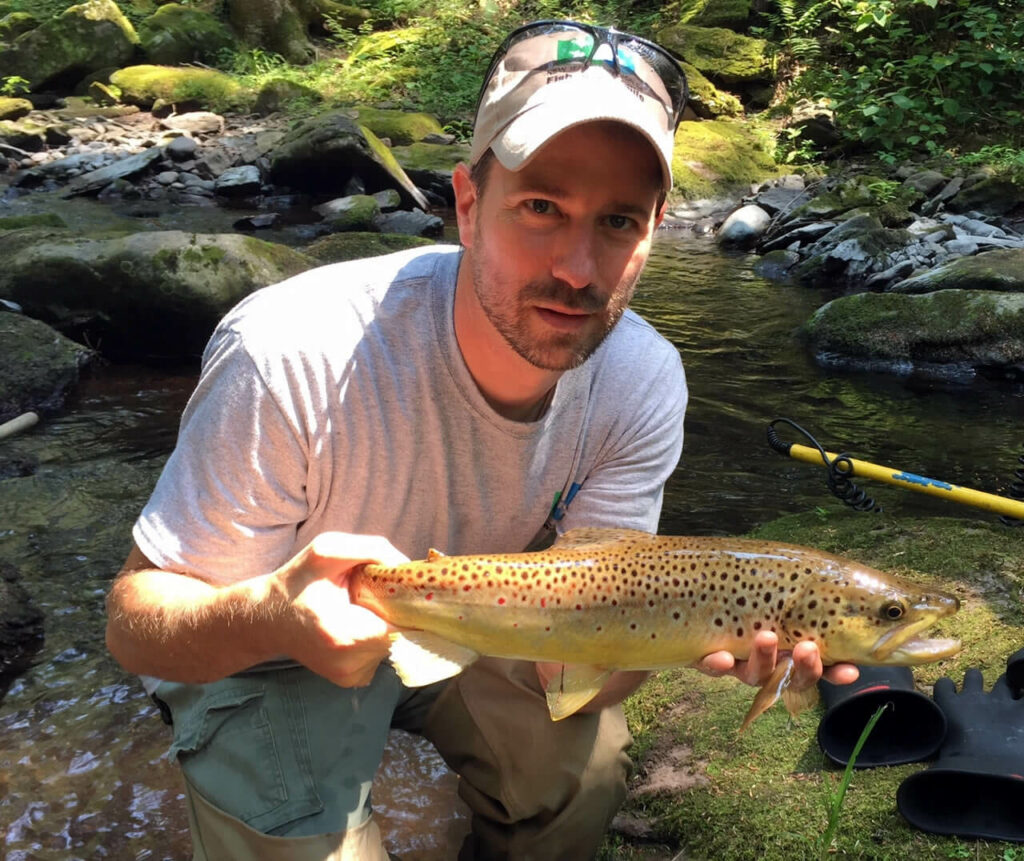Wild Trout in New Jersey
The most densely populated, urbanized state in the nation has four species of trout that reproduce in the wild! Wild Brook, Brown, and Rainbow Trout occur in certain streams while Lake Trout reproduce in two reservoirs. Of these four, only the Brook Trout is truly native, having resided here since the last glacier receded 18,000 years ago. The other three species, stocked over the last century to provide additional sport fishing opportunities, have managed to establish wild, reproducing populations in some waters. The nearly 200 streams that wild trout call home are scattered across 8 counties – Sussex, Warren, Passaic, Morris, Hunterdon, Somerset, Bergen, and Camden. Cradled primarily in the forested hills and mountains of north Jersey, most are small tributaries to, or the headwaters of, major trout-stocked rivers.
Long recognized as indicators of a healthy ecosystem, wild trout need clean, cold water (68°F or less preferred) and rocky-gravel substrate areas for spawning to complete their life cycle. They are vulnerable to water quality and habitat changes that occur all too frequently when human activities encroach on their watershed. The native Brook Trout is the least tolerant of any form of habitat or water quality degradation.
Conservation Milestones
A Wild Trout Stream regulation, established in 1990, gave added protection to wild trout in 29 streams. A statewide 7-inch minimum size for trout (both wild and stocked) was established in 1997 to protect wild trout less than 7 inches from being harvested. This size was increased to 9 inches in 2008 which further protected wild trout from harvest while not impacting the harvest of hatchery trout (typically 10-11 inches or larger when stocked). Between 2005 to 2022 trout stocking was discontinued in 13 streams having wild trout, thereby eliminating competition between wild and stocked trout and allowing these wild populations to flourish and provide recreation.
In 2014, Fish and Wildlife initiated a two-year Wild Trout Stream Assessment to evaluate the status of wild trout populations inhabiting our Wild Trout Streams. 90 surveys were conducted on 57 streams inhabited by wild trout in 2014 and 2015. The data revealed that in many cases wild trout were not overly abundant or very large. The number of trout per survey averaged 68, with 25% of the surveys having 23 trout or less.
Additional information was gathered in 2015, using an online survey taken by wild trout anglers to better understand their motivations and preferences. Coupled with a review of scientific studies that compared hooking mortality associated with various types of terminal tackle.
Following a comprehensive review of this information by Fish and Wildlife biologists, meetings were held to give the public an early opportunity to weigh-in on potential regulation changes. In 2017 the Council proposed and adopted regulation changes for 2018. These changes included several key measures geared to protect this unique resource.
Brook Trout Conservation Zone
Sensitive to change, Brook Trout’s presence is an indicator of excellent water and habitat quality. It is recreationally important and wild populations that were once common within the northern portion of the State have declined. Impacts from urbanization, sedimentation, dams, and other forms of land and water disturbances continue to take their toll. Wild Brook Trout are now present in less than half of the subwatersheds that composed their original range, their populations are fragmented, and their presence in many streams is relegated to headwater areas. Competition from more tolerant non-native trout species poses additional stressors to these struggling populations.
Due to growing concern over the plight of New Jersey’s State fish, all Brook Trout caught within the “Brook Trout Conservation Zone” (BTCZ) must be immediately released unharmed. The Brook Trout Conservation Zone (BTCZ) consists of all waters within the northwest region of the State, where most of our remaining wild Brook Trout populations occur. The BTCZ is bounded by easily discernable boundaries; two major roadways (Interstate 287 and Route 202), the Delaware River, and the NJ-NY state line. This regulation protects all Brook Trout within the BTCZ, including wild Brook Trout that may move from small tributary streams to the mainstem of larger rivers and grow larger than 9 inches, allowing them to survive, reproduce and perpetuate the species.
A component of the catch and release regulation for Brook Trout is that hatchery Brook Trout will no longer be stocked within the BTCZ (because they may not be harvested and to prevent interbreeding with wild Brook Trout). A genetics study completed in 2007 indicated that there are wild Brook Trout populations in New Jersey streams that are most likely descendants of fish that colonized our area after the last glacier retreated. Preventing interbreeding helps safeguard our wild Brook Trout gene pools, preserving their genetic variability and potential to evolve in response to environmental change.
Fish and Wildlife’s trout stocking program is currently unaffected as only Rainbow Trout are currently reared and stocked statewide. If Brook Trout are re-introduced into the state hatchery system they will only be stocked outside of the BTCZ. In addition, private fishing clubs and others who apply for fish stocking permits will not be approved to stock Brook Trout within the BTCZ.
Ultimately, as a result of this change every Brook Trout caught within the BTCZ will be a wild Brook Trout!
A Facelift for the Wild Trout Stream Regulation
What was one regulation in the past, is now a subset of three categories highlighting the variety of wild trout fishing opportunities available, while aligning regulations with specific management strategies. Wild Trout Stream regulations now include these three categories: Native Brook Trout Streams, Wild Trout Streams, and Brown Trout Enhancement Streams.
- Native Brook Trout Streams (Brook Trout Dominant)– This category highlights 11 streams that are almost exclusively inhabited by native Brook Trout or will be as part of active management efforts. There is no minimum size limit, and Fish and Wildlife encourages harvest for Brown and Rainbow Trout in these native trout waters. These efforts are aimed at reducing competition with non-native trout species. All Brook Trout, however, must be immediately released unharmed.
- Wild Trout Streams (Multiple Wild Trout Species Present) – This regulation set is probably the most familiar to wild trout anglers as it is most similar to how all wild trout were regulated prior to 2017. Not much changed in terms of limitations on harvest or minimum size (9 inches, 2 per day). However, the change comes in the form of the streams that are now managed under this regulation. The populations in these streams are mixed, containing more than one species of trout, with Brown Trout and/or Rainbow Trout being very abundant. All streams in this category either have or are connected to streams with Brook Trout. For streams located within the Brook Trout Conservation Zone, all Brook Trout must be immediately released unharmed.
- Brown Trout Enhancement (Brown Trout dominant, other wild trout species may be present) – Thirteen streams fall under this category which carries an increased size limit (12 inches, 2 per day) for Brown Trout. An absence of wild Brook Trout within these streams, or nearby, eliminates concerns of competition. The 12-inch size limit on Brown Trout allows these fish to attain larger sizes which any angler would be delighted catch one of these impressive trout!
Other aspects of the wild trout regulations remain unchanged; these streams are not stocked with hatchery trout, open to fishing year-round, no harvest from September 15 to opening day, and gear is still limited to artificial lures and flies only. Hooks however are now limited to no more than three hook points, all of which must be barbless. When allowed, harvest is limited to two Brown and/or Rainbow Trout per day.
Changes to Wild Trout Stream regulations by nature typically have little impact to Fish and Wildlife’s Trout Stocking Program. The Raritan River South Branch, however, from its source below Budd Lake down to Lake Solitude supports opportunities for both stocked and wild trout. The most upstream section (above the old YMCA dam) is a Wild Trout Stream, managed under the Native Brook Trout Stream category. The river, from the YMCA dam down to the small dam above Schooleys Mountain Rd., is some of the most productive wild trout waters in the state and is now managed under the Wild Trout Stream category. This includes the former Claremont Trout Conservation Area, which is now incorporated into the Wild Trout Stream regulation.
The remaining section of the South Branch of the Raritan River from Schooleys Mtn. Rd. downstream to the confluence with the North Branch of the Raritan River will continue to be stocked. Though due to the impressive wild Brown Trout found between Schooleys Mtn. Rd to Lake Solitude, excluding the Catch & Release Only area, there will be a 12-inch minimum size limit for Brown Trout.
Helping Wild Trout Thrive
The Wild Trout Stream regulation set not only fine tunes management approaches, but also serves as a compass to guide anglers in wild trout fishing opportunities in the Garden State. These Wild Trout regulations shine a light on New Jersey’s wild trout resources and demonstrate that a concerted conservation effort on their behalf is underway. Anglers can take pride in knowing that they too have an important role in conserving wild trout, especially our native Brook Trout.
 Official Site of The State of New Jersey
Official Site of The State of New Jersey



